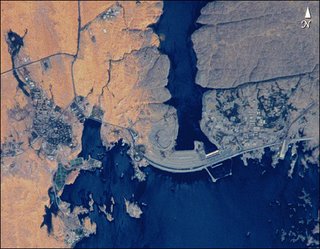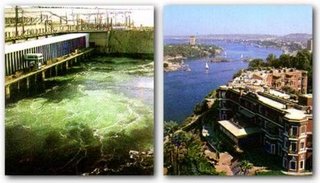Aswan High Dam

The History:
The Aswan High Dam, completed in 1970, controls the largest river in the world, the Nile. It is near the border of Egypt and Sudan and has created the world's third largest reservoir, Lake Nasser. The Nile has a long history of annual flooding which contributes to the fertile soils along its banks. The Aswan dam was built in part to control these flooding cycles as well as to create hydroelectric power from the dam itself. Earlier shorter dams had been built at Aswan in 1889, 1912 and 1933, but they were insufficient to hold back the flood waters and near breechings showed how dangerous these dams could be. The dam, whose estimated cost is thought to be at around $1 billion, was paid for by Egypt with funds obtained from nationalizing the Suez Canal. In 1959 the Soviet Union steeped in as well paid for possibly an entire 1/3 of the cost of the project. They also provided technicians and machinery and the entire dam was designed by the Russian Zuk Hydroproject Institute.

The Bright Side:
The Aswan High Dam contains 17 times the material used in the Great Pyramid of Giza. The Dam is 11,811 feet long, 3215 feet thick at the base and 364 feet tall. It provides irrigation and electricity for the whole of Egypt and provides about a half of Egypt's power supply and has improved navigation along the river by keeping the water flow consistent. The dam created a 30% increase in the cultivatable land in Egypt. The electricity producing capability of the Dam has doubled Egypt's available supply. When the dam first reached its peak production rates, it allowed most of the villages in Egypt to connect to electricity for the first time, a large step in community development. The dam also mitigated the negative effects of the large floods in 1964 and 1973, as well as the droughts in 1972 and 1983. An entire fishing industry was created around Lake Nasser, which increased yields and offered more jobs. Today however this industry is struggling because of the distance from large markets.

The Down Side:
In order to build the dam both people and artifacts had to be moved. Over 90,000 Nubians had to be relocated. Those who had been living in Egypt were moved about 28 miles away but the Sudanese Nubians were relocated 370 miles, a great distance a huge disturbance to their lives. The loss of silt in the flood planes and the nutrients reaching the ocean is a huge problem. Farmers have been forced to use about a million tons of artificial fertilizer as a substitute for the nutrients which no longer fill the flood plain. Fish and shrimp harvests are declining because of a lack of nutrients entering the ocean where the Nile ends. The Nile Delta itself has lost much of its fertility. This silt gets caught in the dam and is slowly lowering the water storage capacity of Lake Nasser. Irrigation practices have led to water-logging of the soils and increased salinity. Many are concerned about the long term effects the dam will have on the ecosystem of the area and its wider impacts. There has also been significant erosion of coastlines due to lack of sand which was once brought by the Nile, all along the eastern Mediterranean. The Swan Dam has actually increased the salinity of the Mediterranean Sea, which affects its outflow current into the Atlantic Ocean. It is being studied and questioned weather this change in outflow properties might have an impact on global weather patterns.
I feel that although dams can do a great deal of good, the environmental damage that they create in the long-run can outweight the benefits they offer. We have other energy alternatives to large scale damming, and I feel that just as in the case of mud-slide areas and areas with a high risk of fire, proper regulating, zoning and public managment needs to be enforced. Nature has its essenital cycles and people need to realize we cannot bottle these forces without significant risk and eventual loss. Dams are increadibly expensive in their construction and maintanence, and they pose a lingering danger to those who live beneath the reservoirs. A look at the aftermath of Hurricane Katrina can show us what can happen when we loose respect and vigilance over our attempts to control natural systems. Today China has built as many dams as the entire rest of the world, and they are in the process of building the Three Gorges Dam. Serious concerns need to be raised about the proliferation of this means of human adaptation.


0 Comments:
Post a Comment
<< Home